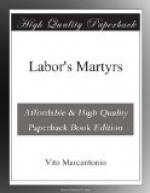Just as the last speaker, Samuel Fielden, was saying, “In conclusion——,” a good part of the crowd had been driven home by rain which began falling when he started his speech—a squad of armed police descended upon the Haymarket Square. Mumbling orders for the crowd to disperse, they fell upon the assembled men and women with clubs and guns.
At that moment, someone—to this day unknown—threw a bomb into the midst of the meeting, killing one policeman outright and wounding scores of people.
These are the facts of the Haymarket meeting and the events which lead up to it. What the press made of it was the prelude to one of the rawest frame-up trials in American history.
All the leading radicals in the city were rounded up and arrested. Many more were indicted in their absence and heavy rewards were posted for their capture. Among these was Albert Parsons, who had left before the end of the meeting, and had fled to a safe hiding place when the man-hunt began. The newspapers from coast to coast, our worthy New York Times not excepted, howled for their blood, raved about an Anarchist plot to blow up Chicago, seize the government, murder, arson, pillage, rape—the whole program which William Randolph Hearst has made only too familiar to the American public.
On June 21, 1886, the trial began. Eight men were singled out as victims—August Spies, Albert Parsons, George Engel, Adolph Fischer, Louis Lingg, Samuel Fielden, Michael Schwab and Oscar Neebe. Efforts to postpone it until the hysteria had died down failed. The men who came forward to defend the Haymarket victims were conservative lawyers headed by one, Captain Black. Convinced of their innocence and enraged by the efforts to railroad them to the gallows, they did their best to provide adequate defense. But they had illusions about the justice available in the American courts. They planned, for instance, to have Parsons walk into the courtroom and surrender himself, asking for a fair trial! This they were sure would make a “good impression” on the judge and jury!
The judge, Judge Gary, gave one of the most shameful performances that this country has ever seen, and it has seen plenty from its judges. He helped choose the jury—–to make sure it would convict. He questioned men who stated they had already formed an opinion about the case, had definite prejudices against Anarchists, Socialists and all radicals, were not certain they could render an impartial verdict—and ruled that they were not disqualified! He said from the bench that “Anarchists, Socialists and Communists were as pernicious and unjustifiable as horse thieves,” and, finally, in charging the jury, that even though the state had not proved that any of the eight men on trial had actually thrown the bomb, they were nevertheless guilty of a conspiracy to commit murder.
The bigoted speeches of the prosecutor Grinnell, and his aides, are equalled only by the speeches of the prosecution in the Mooney case, the Herndon case, the Scottsboro case. In other words, they established a fine precedent for all anti-labor prosecutions to follow.




